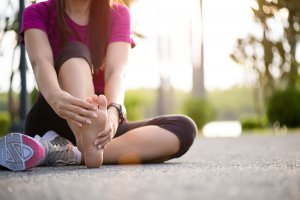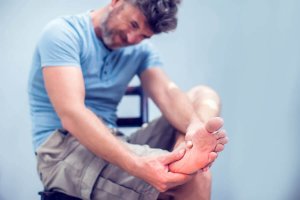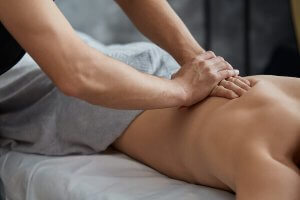How to Avoid Cramps When You Exercise

A cramp is an uncomfortable and painful feeling that forces you to stop working out. You’ve probably suffered from several cramps during your life? This might have been from playing sports, playing in the ocean, or even at night while you sleep! In this article, we’re going to talk about this problem during exercise and what you can do to avoid cramps.
Cramps
Let’s define this concept before we dive into the keys to prevention. A camp is a subtle and involuntary contraction of one or more muscles.
While there’s no one clear cause, the following factors influence their appearance:
- Excessive use: when exercising, it’s usually a result of continuous force or an increase in intensity higher than your body can tolerate. An incorrect technique can also cause cramps.
- Dehydration: if the muscle doesn’t have the resources it needs, then it might develop spasms. This applies not just to water, but to electrolytes.
- Poor blood flow to the muscles.
- Others: nerve problems, certain medicines, pregnancy.

How to avoid cramps when exercising
If cramps appear when you’re exercising, it’s useful to keep the following points in mind to avoid cramps:
- Moderation: as with many illnesses and injuries, you have to do types of exercise that your body can handle. You should always keep in mind the recommended times for activity and rest, and it’s absolutely fundamental that any increase in weight or intensity is gradual.
- Good material and correct form: you’ve got to make sure that you have the correct equipment for your activity. Especially when it comes to shoes, good equipment will always help you. You also have to make sure that your form is good. Just as with other ailments, doing something quickly in which the muscles aren’t working well can give rise to injuries.
- Keep an eye on your hydration and diet: you’ll get cramps more often if you’re not properly hydrated, especially if you work out in humid or hot climates. Because of this, it’s vital to drink enough water before, during, and after exercise. When it comes to eating, you have to make sure that you consume enough calcium, magnesium, and salt. Generally, a balanced diet will be enough as long as you increase your liquid intake on work out days.
- Stretches: it’s important to stretch when you finish working out to reduce the pressure on the muscle fibers and help oxygenate that part of the body.
- Massage: if you’re tense and you have an intense work out session, a good massage in the area can be highly effective.

Treatment
In many cases, cramps will go away on their own if you stop exercising and give the affected muscles time to recover. If you want to speed up the recovery or the discomfort doesn’t go away, you can stretch the muscle or muscle group in question. That way you’ll improve circulation, help to avoid cramps in the future and reduce the pressure over the muscle fibers.
It’s also a good idea to gently massage the area. Pressing lightly on the affected area in circular motions all over the muscle can help a lot.
If you pay attention to all of these tips and still experience frequent cramps, you should see a doctor. During the visit, you can figure out if there are any serious causes behind those injuries. Their appearance in the above-mentioned situations is natural and understandable, but if you suffer from them every day, it’s important to find out why.
A cramp is an uncomfortable and painful feeling that forces you to stop working out. You’ve probably suffered from several cramps during your life? This might have been from playing sports, playing in the ocean, or even at night while you sleep! In this article, we’re going to talk about this problem during exercise and what you can do to avoid cramps.
Cramps
Let’s define this concept before we dive into the keys to prevention. A camp is a subtle and involuntary contraction of one or more muscles.
While there’s no one clear cause, the following factors influence their appearance:
- Excessive use: when exercising, it’s usually a result of continuous force or an increase in intensity higher than your body can tolerate. An incorrect technique can also cause cramps.
- Dehydration: if the muscle doesn’t have the resources it needs, then it might develop spasms. This applies not just to water, but to electrolytes.
- Poor blood flow to the muscles.
- Others: nerve problems, certain medicines, pregnancy.

How to avoid cramps when exercising
If cramps appear when you’re exercising, it’s useful to keep the following points in mind to avoid cramps:
- Moderation: as with many illnesses and injuries, you have to do types of exercise that your body can handle. You should always keep in mind the recommended times for activity and rest, and it’s absolutely fundamental that any increase in weight or intensity is gradual.
- Good material and correct form: you’ve got to make sure that you have the correct equipment for your activity. Especially when it comes to shoes, good equipment will always help you. You also have to make sure that your form is good. Just as with other ailments, doing something quickly in which the muscles aren’t working well can give rise to injuries.
- Keep an eye on your hydration and diet: you’ll get cramps more often if you’re not properly hydrated, especially if you work out in humid or hot climates. Because of this, it’s vital to drink enough water before, during, and after exercise. When it comes to eating, you have to make sure that you consume enough calcium, magnesium, and salt. Generally, a balanced diet will be enough as long as you increase your liquid intake on work out days.
- Stretches: it’s important to stretch when you finish working out to reduce the pressure on the muscle fibers and help oxygenate that part of the body.
- Massage: if you’re tense and you have an intense work out session, a good massage in the area can be highly effective.

Treatment
In many cases, cramps will go away on their own if you stop exercising and give the affected muscles time to recover. If you want to speed up the recovery or the discomfort doesn’t go away, you can stretch the muscle or muscle group in question. That way you’ll improve circulation, help to avoid cramps in the future and reduce the pressure over the muscle fibers.
It’s also a good idea to gently massage the area. Pressing lightly on the affected area in circular motions all over the muscle can help a lot.
If you pay attention to all of these tips and still experience frequent cramps, you should see a doctor. During the visit, you can figure out if there are any serious causes behind those injuries. Their appearance in the above-mentioned situations is natural and understandable, but if you suffer from them every day, it’s important to find out why.
All cited sources were thoroughly reviewed by our team to ensure their quality, reliability, currency, and validity. The bibliography of this article was considered reliable and of academic or scientific accuracy.
- Calambres. O. Steichen, A. Ameri. EMC. Tratado de Medicina. Vol. 14, Issue 4 (2010); 1-8
- J. Morente. Etiología de los calambres asociados a la práctica deportiva. Trabajo de Fin de Grado, Universitat Jaume I (2019)
- J. Cabanyes. Protocolo diagnóstico de las contracturas musculares. Medicine. Programa de Formación Médica Continuada Acreditado. Vol. 11, Issue 75 (2015); 4528-4531
This text is provided for informational purposes only and does not replace consultation with a professional. If in doubt, consult your specialist.








